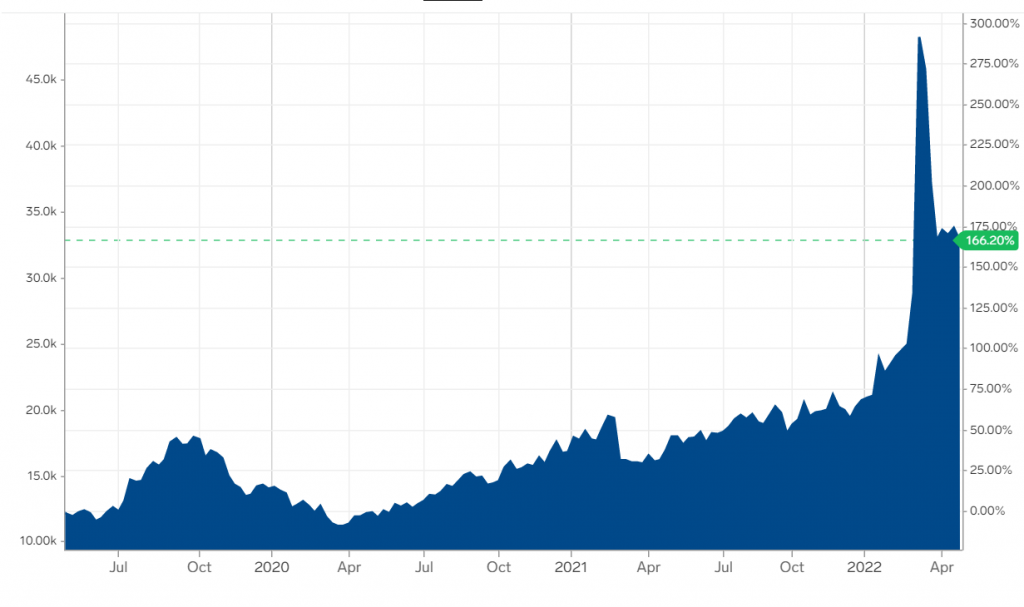Lithium-Ion Batteries: Hot growth, pressure, and looking toward the future
A technology only a few decades old is driving the future of transportation for the next century. Inspection is helping us keep up.
Today’s rechargeable batteries, led by lithium-ion chemistry, are in many ways proven, and yet so challenging at the same time.
Developed in the 80s and 90s, lithium-ion batteries (LIB) made their first big impact on mobile devices: smartphones, tablets, cameras, and power tools. This is only possible because LIB are good. Their high energy densities and voltage, stability, low weight, long life cycle, and diversity of chemistries make them groundbreaking, so far ahead of previous rechargeable battery technologies. Their use has been expanding ever since, with demand continuing to grow rapidly worldwide.
Today, consumer electronics represent only 20% of the demand for LIB, and that number is expected to keep falling. Instead, the future will be in driving the global transport and energy systems to electric power and enabling a more decarbonized future for humanity. According to the World Economic Forum, passenger cars will account for 60% of global battery demand by 2030. Along with commercial transportation and the energy sector, the global market for lithium-ion batteries is forecast to grow at a CAGR of around 20% from 2022-2027, reaching a market size of US $200 billion in 2027. Electric vehicles (EVs) are transforming the automotive and transportation industry and are expected to account for most of lithium-ion battery demand. Frost & Sullivan expects between 12 million and 15 million EV sales in 2025, a tenfold increase in global lithium-ion battery capacity from 2018. According to Frost and Sullivan, Asian battery manufacturers had the first-mover advantage, due in part to the high demand for EVs in China and have already accounted for about 70% of global lithium-ion cell production.
Rechargeable battery technology isn’t static, either. As multiple companies look to make improvements in performance, efficiency, and quality, their solutions continue to morph and change.
And if the world is going to have a chance of reaching zero carbon emissions, rechargeable batteries will be a critical part of the solution.
Speedbumps on the road to global ubiquity
Still, there are risks. LIB are complicated to make, especially for EV applications where safety, durability and modularity compete with competitive pressures on performance, efficiency and price. Individual cells must be produced and then assembled into battery modules containing hundreds of cells. Like in any manufacturing process, perfection is the goal, not a destination. There are always limits to yield. This is complicated by the fact that a single cell failure can necessitate the disassembly of an entire module and removal of the failed cell or cells. Undiscovered failed cells are even worse: they can greatly degrade the output power and performance of the whole module, or even present hazards.
In 2018, the U.S. National Transportation Safety Board investigated a series of fires in Tesla vehicles, looking at whether the high-voltage LIB posed safety risks to first responders after crashes.
In 2021, Australia, perhaps the country most committed to bringing lithium batteries into its electrical grid, also faced challenges with battery systems. In 2021, it saw a fire at its big battery system in Victoria during testing. Now, investigations are underway regarding power grid failures where the battery-based backup systems didn’t meet expectations. The causes are still unclear.
In April 2022, U.S. safety regulators have opened a new investigation into electric and hybrid vehicle batteries after five automakers issued recalls due to possible defects that could cause fires or stalling. The National Highway Traffic Safety Administration said the new probe covers more than 138,000 vehicles with batteries made by LG Energy Solution of South Korea and affects cars made by General Motors, Mercedes-Benz, Hyundai, Stellantis and Volkswagen.
While these cases are concerning, they are not surprising. The current safety and quality standards of manufacturing for fossil fuel and internal combustion engines has benefited from more than 100 years of refinement. Although EV have also a long history, their accelerated mass production development did not take place until the 1990’s where NiMH (Nickel Metal Hydride) batteries were used for EV and LIB developed into a viable alternative.

Safer Batteries Through Inspection
More demanding applications for LIB require us to develop a better understanding of the performance, degradation, and hazards of both materials and devices. The failure of a battery system in almost any electric system poses multiple hazards. Lacking a long track record on standardized equipment to understand the risks, there’s a strong case for increasing quality control testing on all individual cells before and after they are assembled into modules. While each cell and module likely have their current tested at different stages, this only provides a partial understanding.
The best quality strategy is to start inspection as early in the production process as possible, so as not to waste time and resources on scrapping or recycling nearly finished product. Early defect detection allows manufacturers to finetune the feedback loop, adjusting process machinery to optimize results.
As we saw in an earlier Possibility article, the first visual inspection happens in the manufacture of foils, which are used to make the electrodes (cathodes and anodes). The quality and consistency of the foils and their coatings are critical to the function and safety of the cells: foreign particles, bumps and non-uniformities which can over time press or rub through the separator foil, thus causing a short circuit resulting in catastrophic battery failure. Typically, this inspection is done after the slicing or punching processes which can cause particles to be deposited on the surface prior to the rolling, folding, or stacking of the electrodes.
Often, it’s a matter of a few dark grey defects on a dark grey background that can determine the performance and lifetime of a battery cell. Manufacturers are finding it important to look for these defects from the 50-micron level all the way down to 10 microns. Contact imaging is often used for a ‘rough’ initial pass, but for detailed inspection further down the line, companies turn to line scan cameras, and high-sensitivity TDI (Time Delay & Integration) cameras to provide the necessary resolution and sensitivity.
More innovative solutions have included Multi-Field TDI cameras that provide the additional benefit of simultaneously capturing light from three different spectra and angles, providing more image data for defect detection and analysis without incurring further costs or slowing the system.
Other types of imaging are used at different stages of assembly. High-speed 3D laser profilers are used to measure the form of more 3-dimensional objects such as the contact tab welding uniformity, tab deformity and orientation. A poorly welded contact tab can break or cause an intermittent loss of contact. Area scan cameras are used primarily in the packaging of individual cells into larger batteries, where the orientation of hundreds of cells in the housing must be precisely controlled.
Once assembled, the ‘black box’ nature of battery modules, especially in transportation applications with higher levels of sealing and protection presents problems: how do you inspect if you can’t see inside? That requires imaging beyond the visual range.
For example, the Battery Innovation Center (BIC) focuses on the rapid development, testing, validation, and commercialization of safe, reliable, and lightweight batteries for both commercial and defense applications. Their process includes extensive abusive (or destructive) testing, exposing batteries to some worst-case scenario to understand any resulting safety issues. To gather the most data possible from these tests, BIC uses a Teledyne FLIR high-speed thermal camera to reveal heat details other technology can’t capture.
With thermal imaging, engineers can easily see what’s going on outside the battery when damaged, and what’s happening inside and how the heat is progressing.
Researchers have also looked at different types of X-ray diffraction for in situ analysis, including X-ray and even ultrasound imaging. This allows the analysis of the physical structure and materials of the battery, providing clues to physio-chemical reactions associated with battery operation and degradation. Although CT analysis cannot reveal the electrochemistry within the cell, it can reveal the mechanical inner workings. A thermal runaway fire can have mechanical causes, but electrochemical processes can leave mechanical evidence. As with any application, there is a balance between image quality and time.
Some of this can be done with fast 2D X-ray systems, but visible information is limited. With 3D X-ray imaging, it’s possible to get a full picture for critical aspects of a battery cell and module, while time-lapse (4D) tomography is helping reveal the processes and transformations in an operational battery as it ages.
Industrial computed tomography (CT) is finding more uses in detecting defects and internal changes throughout a battery’s lifecycle. Still, it can be difficult to make out the interesting structures: with the materials being very similar in density and often quite thin, the result is often a low-contrast grayscale image. CT-data analysis and visualization software are adding functions that allow a more informed look with the help of artificial intelligence.
Dynamic Neutron Radiography has proven to be another promising option for non-destructive testing, giving researchers real-time data on the inner workings of a system. In comparison to X-rays, neutron interactions offer some useful advantages to X-ray imaging, as they interact differently with elements. Firstly, lithium and the liquid electrolyte inside batteries are extremely sensitive, and neutron methods have a lower chance of adverse reactions. Second, the high visibility of neutrons for lighter weight elements like hydrogen and lithium enables the direct observation of key battery processes, such as lithium diffusion, electrolyte consumption, and gas formation. Researchers are still working to help neutron imaging catch up with the spatial and temporal resolutions of today’s CT scans, where this kind of diffraction imaging can help us better tackle the challenges of current and next-generation battery chemistries.
For deeper analysis of the non-structural conditions within the battery, some researchers have turned to electron microscopy, which can reveal the electrochemical reactions within a battery. Like neutron imaging, resolution can still be a challenge, but the field is advancing very quickly. There is a strong potential that this kind of imaging will improve our fundamental knowledge of the nanoscale electrochemistry events inside all kinds of rechargeable ion batteries.
The Unpredictable Future of Battery Cell Manufacturing
Today it seems that from an R&D perspective, the LIB technology is mature and it’s more about optimizing product and production. Optimization is driving promising moves toward new chemistries to make batteries more cost-effective and environmentally friendly.
For example, cobalt is one of the primary metals in lithium-ion batteries, because the metal increases battery life and energy density. But cobalt is one of the most expensive materials in a battery. While battery prices have fallen 89% between 2010 and 2021, they still make up about 30% of the total cost of an electric vehicle. With EV sales worldwide growing rapidly, demand for raw battery materials like cobalt is expected to outstrip supply. Solutions that obviate the use of cobalt (and even lithium, both of which have sparked serious environmental and human rights concerns) are becoming more attractive.
Some of those solutions rely more heavily on nickel, which brings its own challenges. In the beginning of 2020, Indonesia, which controls a quarter of the world’s supply of nickel, put a halt to its nickel exports two years early. But the vagaries of the pandemic and global finance led to the price of nickel falling, hurting investment in companies that otherwise would have invested in increasing their nickel output, only to skyrocket in early 2022.

New technologies will be introduced to overcome one of the fundamental drawbacks of current LIBs: The liquid, fluorine-containing, and highly flammable electrolyte. This ingredient poses severe challenges for handling, storage, and potential recycling) of the battery cells. Emerging energy storage technologies based on more abundant materials like magnesium show promise. Batteries made from magnesium metal could have higher energy density, greater stability, and lower cost than today’s lithium-ion cells. Another promising direction lies in a move to solid-state designs that are much more stable but aren’t (yet) competitive in performance.
Today, and for the foreseeable future, the hurdle for LIB and its analogues will continue to be manufacturing reliable, high-quality cells in the face of constant optimization and the fluctuations of a global supply chain. This may influence the designs that manufacturers pursue, and the tools they use to perfect and inspect them.



 How Machine Vision is Enabling the Future of Lithium-Ion Batteries
How Machine Vision is Enabling the Future of Lithium-Ion Batteries  Bright Light, Big Future: Solar Power on the Rise
Bright Light, Big Future: Solar Power on the Rise 